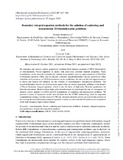Mostrar el registro sencillo del ítem
Boundary integral equation methods for the solution of scattering and transmission 2D elastodynamic problems
| dc.creator | Domínguez Baguena, Víctor | es_ES |
| dc.creator | Turc, Catalin | es_ES |
| dc.date.accessioned | 2023-01-25T07:50:41Z | |
| dc.date.available | 2023-01-25T07:50:41Z | |
| dc.date.issued | 2022 | |
| dc.identifier.citation | Domínguez, V., & Turc, C. (2022). Boundary integral equation methods for the solution of scattering and transmission 2D elastodynamic problems. IMA Journal of Applied Mathematics, hxac018. https://doi.org/10.1093/imamat/hxac018 | en |
| dc.identifier.issn | 0272-4960 | |
| dc.identifier.uri | https://hdl.handle.net/2454/44596 | |
| dc.description.abstract | We introduce and analyse various regularized combined field integral equations (CFIER) formulations of time-harmonic Navier equations in media with piece-wise constant material properties. These formulations can be derived systematically starting from suitable coercive approximations of Dirichlet-to-Neumann operators (DtN), and we present a periodic pseudodifferential calculus framework within which the well posedness of CIER formulations can be established. We also use the DtN approximations to derive and analyse OS methods for the solution of elastodynamics transmission problems. The pseudodifferential calculus we develop in this paper relies on careful singularity splittings of the kernels of Navier boundary integral operators, which is also the basis of high-order Nystrom quadratures for their discretizations. Based on these high-order discretizations we investigate the rate of convergence of iterative solvers applied to CFIER and OS formulations of scattering and transmission problems. We present a variety of numerical results that illustrate that the CFIER methodology leads to important computational savings over the classical CFIE one, whenever iterative solvers are used for the solution of the ensuing discretized boundary integral equations. Finally, we show that the OS methods are competitive in the high-frequency high-contrast regime. | en |
| dc.description.sponsorship | Catalin Turc gratefully acknowledges support from National Science Foundation (NSF) through contract DMS-1614270 and DMS-1908602. | en |
| dc.format.mimetype | application/pdf | en |
| dc.language.iso | eng | en |
| dc.publisher | Oxford University Press | en |
| dc.relation.ispartof | IMA Journal of Applied Mathematics 2022, 87 (4),647-706 | en |
| dc.rights | © The Author(s) 2022. This is an Open Access article distributed under the terms of the Creative Commons Attribution License, which permits unrestricted reuse, distribution, and reproduction in any medium, provided the original work is properly cited. | en |
| dc.rights.uri | http://creativecommons.org/licenses/by/4.0/ | |
| dc.subject | Time-harmonic Navier scattering and transmission problems | en |
| dc.subject | Boundary integral equations | en |
| dc.subject | Preconditioners | en |
| dc.subject | Domain decomposition methods | en |
| dc.subject | AMS subject classifications | en |
| dc.title | Boundary integral equation methods for the solution of scattering and transmission 2D elastodynamic problems | en |
| dc.type | Artículo / Artikulua | es |
| dc.type | info:eu-repo/semantics/article | en |
| dc.date.updated | 2023-01-25T07:39:54Z | |
| dc.contributor.department | Estadística, Informática y Matemáticas | es_ES |
| dc.contributor.department | Estatistika, Informatika eta Matematika | eu |
| dc.contributor.department | Institute for Advanced Materials and Mathematics - INAMAT2 | es_ES |
| dc.rights.accessRights | Acceso abierto / Sarbide irekia | es |
| dc.rights.accessRights | info:eu-repo/semantics/openAccess | en |
| dc.identifier.doi | 10.1093/imamat/hxac018 | |
| dc.relation.publisherversion | https://doi.org/10.1093/imamat/hxac018 | |
| dc.type.version | Versión publicada / Argitaratu den bertsioa | es |
| dc.type.version | info:eu-repo/semantics/publishedVersion | en |



